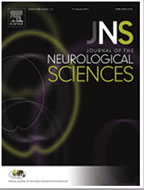
John D. England, MD
By John D. England, MD
August 2016 was an awful month for the world of neurology and the Journal of the Neurological Sciences. We suffered the loss of two outstanding academic neurologists, Omar Khan, MD, and Donald Gilden, MD. Both were valuable members of the Editorial Board of the Journal of the Neurological Sciences, and both were outstanding neurologists and academic teachers and researchers. Their loss creates a great void in the world of neurology.
Dr. Khan, professor and chair of the department of neurology at Wayne State University, passed away Aug. 13 at age 53. He had been a faculty member at Wayne State since 1998 and chair of the department of neurology since 2012. He was an internationally known expert in multiple sclerosis and served as the director of the Wayne State University Multiple Sclerosis Center and Magnetic Resonance Image Analysis Laboratory. He served as principal investigator of more than 55 clinical trials and published extensively in the field of multiple sclerosis. He was extraordinarily helpful as a reviewer and Editorial Board member of the Journal of the Neurological Sciences.
 Dr. Gilden, professor and former chair of the department of neurology at the University of Colorado School of Medicine, passed away Aug. 22 at age 78. He was the department’s longest-serving chair (1985-2009) and led the department into an era of prominence. He exemplified the fast-disappearing triple threat academic with his outstanding abilities in clinical neurology, education, and basic research. He was internationally renowned as a foremost expert in the biology and pathogenesis of varicella zoster virus (VZV). He was the first to demonstrate that VZV DNA can be found in normal human sensory ganglia neurons, and described VZV-vasculopathy of brain. His most recent studies concentrated upon the association of VZV with giant cell (temporal) arteritis. He authored or co-authored 420 papers, many of which are now seminal articles in the field of neuro-virology and neurology. On a personal note, I owe him a great debt of gratitude since he offered me my first academic faculty position and helped guide my academic career. He was a tireless and gifted reviewer and contributor to the Journal of the Neurological Sciences.
Dr. Gilden, professor and former chair of the department of neurology at the University of Colorado School of Medicine, passed away Aug. 22 at age 78. He was the department’s longest-serving chair (1985-2009) and led the department into an era of prominence. He exemplified the fast-disappearing triple threat academic with his outstanding abilities in clinical neurology, education, and basic research. He was internationally renowned as a foremost expert in the biology and pathogenesis of varicella zoster virus (VZV). He was the first to demonstrate that VZV DNA can be found in normal human sensory ganglia neurons, and described VZV-vasculopathy of brain. His most recent studies concentrated upon the association of VZV with giant cell (temporal) arteritis. He authored or co-authored 420 papers, many of which are now seminal articles in the field of neuro-virology and neurology. On a personal note, I owe him a great debt of gratitude since he offered me my first academic faculty position and helped guide my academic career. He was a tireless and gifted reviewer and contributor to the Journal of the Neurological Sciences.
In our ongoing attempt to inform readers of important and interesting new developments in the journal, the editorial staff has selected two new “free-access” articles for our readership.
- Joel Huovinen and colleagues from Finland describe a probable familial subgroup of idiopathic normal pressure hydrocephalus (iNPH) from a nation-wide Finnish cohort of 375 shunt-operated patients with iNPH. A total of 60 patients (16%) had possible or probable familial iNPH. Eighteen (4.8%) had probable iNPH and 42 (11%) had possible familial iNPH. The familial iNPH patients had an approximately threefold risk of dementia compared to the sporadic iNPH patients. This study suggests that screening for familial iNPH is indicated for both clinical and research purposes. Identified familial cases should provide an opportunity to study the characteristics and genetic markers of this disease. Joel Huovinen et al., Familial Idiopathic Normal Pressure Hydrocephalus, J. Neurol. Sci. 368 (2016) 11-18. http://www.jns-journal.com/article/S0022-510X(16)30384-7/fulltext.
- The Zika virus epidemic has become an important topic for public health and global neurology. Several neurological complications of Zika virus infection have been described, including the congenital Zika virus infection syndrome in babies, and meningoencephalitis, acute myelitis, and post-infectious Guillain-Barre syndrome in adults. In conjunction with the World Federation of Neurology Zika Work Group, Marco Medina, MD, and colleagues describe the first reported case of a reversible sensory polyneuropathy associated with acute Zika virus infection. The patient was a 62-year old Honduran man who developed an acute “patchy” non-fiber-length-dependent sensory polyneuropathy associated with acute (laboratory-proven) Zika virus infection. The sensory polyneuropathy affected mainly the small sensory fibers and to a much lesser extent larger myelinated sensory fibers. The fact that the neuropathy began during the acute stage of the infection suggests a probable direct viral inflammatory process affecting sensory nerves. Marco Medina, et al., Zika Virus Associated With Sensory Polyneuropathy, J. Neurol. Sci. 369 (2016) 271-272. http://www.jns-journal.com/article/S0022-510X(16)30535-4/fulltext.
